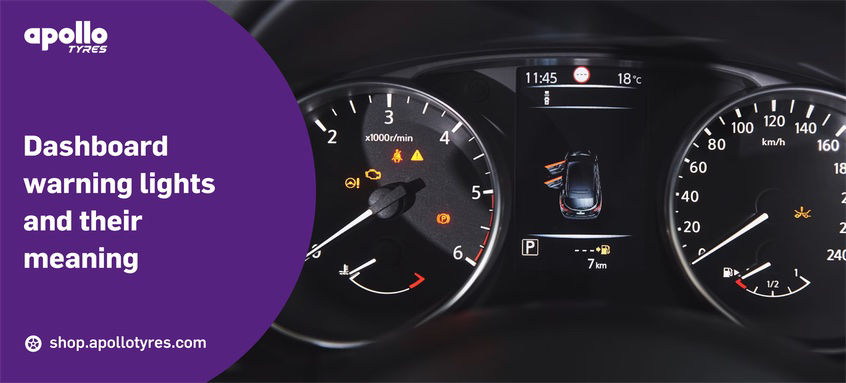
Modern cars are equipped with advanced technology that provides drivers with essential information about the vehicle's condition. One of the primary ways cars communicate with their drivers is through warning lights displayed on the dashboard. These lights, often accompanied by symbols, indicate various issues that require attention. Understanding these car warning lights and their meanings is crucial for every driver. In this article, we will decode the common car warning lights and symbols, helping you stay informed and safe on the road.
1. Engine Warning Light:
The engine warning light, often depicted as an outline of an engine, is one of the most important warning lights on your dashboard. When this light illuminates, it signifies a potential issue with the engine or its components. It could indicate anything from a loose gas cap to a severe engine malfunction. If this light comes on, it's crucial to have your vehicle inspected by a mechanic as soon as possible to prevent further damage.
2. Battery Warning Light:
The battery warning light, usually resembling a battery icon, indicates a problem with the car's charging system. It might imply a faulty battery, a malfunctioning alternator, or a broken belt. If this light appears, your vehicle might stall soon, so it's advisable to pull over safely and seek assistance.
3. Oil Pressure Warning Light:
The oil pressure warning light, depicted as an oil can, signals low oil pressure. Low oil pressure can lead to engine damage, so it's essential to check your oil level immediately. If the light persists even after adding oil, consult a mechanic to inspect the oil pump and other related components.
4. Brake System Warning Light:
The brake system warning light, often displaying an exclamation mark within a circle, warns of issues with the brake system. It could indicate low brake fluid, worn brake pads, or a malfunction in the anti-lock braking system (ABS). Driving with faulty brakes is extremely dangerous, so address the problem promptly.
5. ABS Warning Light:
The ABS warning light, represented by the letters ABS inside a circle, alerts you to a problem with the anti-lock braking system. While your conventional brakes will still function, the ABS may not work correctly, particularly in slippery conditions. Get it checked to ensure optimal braking performance, especially in emergencies.
6. Tire Pressure Monitoring System (TPMS) Light:
The TPMS light, often resembling an exclamation mark inside a horseshoe, notifies you about low tire pressure. Underinflated tires can compromise handling and fuel efficiency while increasing the risk of a blowout. Check and adjust tire pressure according to your vehicle's specifications to keep your tires in good condition.
7. Coolant Temperature Warning Light:
The coolant temperature warning light, usually depicting a thermometer or waves, indicates an overheating engine. This could be due to low coolant levels, a malfunctioning thermostat, or a faulty radiator fan. Pull over and turn off your engine immediately if this light comes on to prevent engine damage. Let the engine cool down before checking the coolant level and consulting a mechanic.
8. Airbag Warning Light:
The airbag warning light, represented by a seated passenger with a deployed airbag, alerts you to a problem with the airbag system. If this light is on, it means the airbags might not deploy correctly during an accident. Ensure your safety by having the system inspected and repaired by a professional.
9. Fuel Warning Light:
The fuel warning light, usually depicting a fuel pump or a gas can, indicates low fuel levels. Running out of fuel can leave you stranded, so it's essential to refuel your vehicle promptly after this light comes on. Avoid letting your fuel level drop too low regularly, as it can damage the fuel pump.
10. Transmission Warning Light:
The transmission warning light, often resembling a gear icon, signals issues with the transmission system. This could range from low transmission fluid to more severe mechanical problems. Driving with transmission issues can cause further damage, so it's best to have your vehicle towed to a repair shop.
In addition to these common warning lights, there are other symbols on your car's dashboard that might indicate less critical issues. These include:
1. Washer Fluid Warning Light:
This light, often depicting a windshield with wavy lines, alerts you to low windshield washer fluid. While not critical for driving, maintaining a clear windshield is essential for visibility. Refill the washer fluid reservoir as soon as possible.
2. ESP/BAS Warning Light:
The Electronic Stability Program (ESP) or Brake Assist System (BAS) warning light informs you about issues with your vehicle's stability control or brake assist system. While your vehicle is still drivable, it's crucial to have it inspected to ensure your safety, especially during emergency maneuvers.
3. Glow Plug Indicator (Diesel Engines):
This light appears on diesel vehicles and indicates that the engine's glow plugs are warming up. It usually turns off after a few seconds, signaling that the engine is ready to start. If this light stays on for an extended period, it might indicate a problem with the glow plug system.
In Conclusion
Understanding the meanings of car warning lights and symbols is essential for every driver. Regularly checking your vehicle's manual to familiarize yourself with these symbols can help you respond promptly and appropriately when they illuminate. Ignoring these warning lights can lead to costly repairs, compromised safety, and even accidents.
If any warning light appears on your dashboard, it's always better to err on the side of caution. Pull over safely, consult your vehicle's manual, and assess the situation. In many cases, you might need to seek professional assistance. By staying informed and proactive, you can ensure your safety and the longevity of your vehicle, making every journey a smooth and secure experience on the road.

